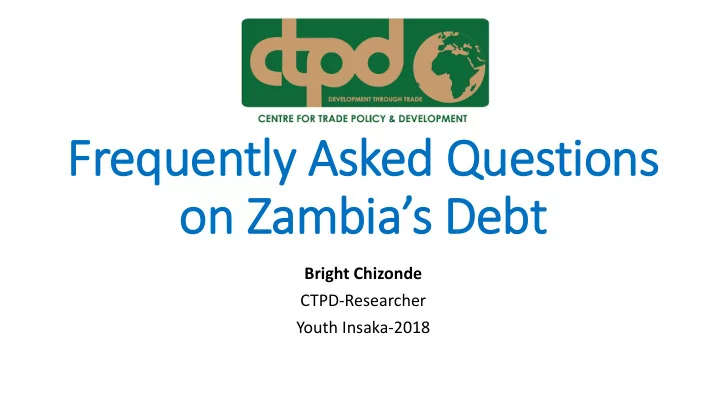

Frequently Asked Questions on Zambia’s Debt Bright Chizonde CTPD-Researcher Youth Insaka-2018
Outline • Q1. What is Public Debt? • Q2. Is debt Bad for the Country? • Q3. How Much Debt do we have? • Q4. When did we accumulate this Debt? • Q5. Are we able to pay back this debt? • Q6.What is the cost of paying back this debt? • Q7. What should be done about Zambia’s debt?
Q1. What is Public Debt? • A country’s Public debt , also known as government debt or national debt , is money or credit owed by any level of government. • Since the government represents the people, public debt is considered to be an indirect debt of the taxpayers in that country. (Source: UNDP, 2007)
Q1. What is Public Debt? • Public debt has a number of categorizations : These include: • 1. External or Domestic • Domestic debt or internal debt is owed to lenders within the country while external or foreign debt is owed to foreign lenders . • 2. Concessional or commercial • Concessional have more generous terms (e.g. from IMF with low interest rates than market loans) while commercial are less generous with market interest rates (e.g. Eurobonds from financial market) • 3. Multilateral or bilateral • Multilateral debt is from organizations representing a group of countries (e.g. IMF or World Bank) bilateral debt is from single countries (e.g. China)
Public Debt in in Zambia
Q2. . Is Is debt Bad for the Country ry? • “ Debt can accelerate growth through investment in growth enhancing projects . However, when debt is accumulated to levels where it causes a debt overhang , it can lead to deceleration in economic growth and provision of social services ” • Mr. Mukuli Chikuba (permanent secretary-economic management and finance, Ministry of Finance)
Q3. How Much Debt do we have? • 1. Domestic Debt : K51.87 billion This is about K3,700 per Zambian. • 2. External Debt: K 93.7 billion This is about K6,700 per Zambian. • 3. Public Arrears: K 13.9 billion (unpaid payments which are due) This is about K 993 per Zambian • TOTAL PUBLIC DEBT: K159.5 Billion This is about K 11,400 per Zambian (Source: Ministry of Finance, June 2018)
Q4. . When did id we accumulate this is Debt? • “Most of Zambia’s current debt was accumulated between 2010 (20 % of GDP) and 2018 (58.2% of GDP) after the Issuance of three Eurobonds on the financial Market” Eurobonds (Non-Concessional, 7.6% average) • 2012: $750 million to be paid back in 2022 • 2014: $ 1 billion to be paid back in 2024 • 2015: $ 1.25 billion to be paid back over 2025-2027
Q5 Are we able to pay back? • “Zambia’s public debt has been rising on unsustainable pace and now there is a big risk of debt distress . Zambia’s public debt is much higher than the rest of the countries in the region.. which is very worrying,” -Dr. Alfredo Baldini Former Zambia-IMF Resident Representative.
Q6.What is is the cost of paying debt? • 1. Debt payments reduce government spending on important services such as education and health . For example: In 2018, government spent 10 percent of the budget on debt payments and spent 9 percent on health provision. • 2. High debt reduces Economic growth and development through lower foreign and local investment. • 3. High debt leads to increased taxes -government turns to collecting more taxes in order to pay back debt.
Some taxes/tariffs in in Zambia Tall Gates charge Internet calling tariff Rentals Withholding tax TV levy Borehole drilling charge Teacher registration charge UNZA/CBU students loans Road Traffic camera penalty Re-registration of vehicles PAYE tax Customs duty Road Tax Excise duty Health insurance contribution Etc., etc., etc.
Q7. . What should be done about Zambia’s debt? To deal with this looming debt crisis, the following should be done: • 1. Government should stop contracting more debt and spend within its means. • 2. Government should refinance (extend the payment plans for debt in order to reduce tax burden on people) • 3. Government should set up a sinking fund ( put money aside which will be used to pay back debt in future) • 4. Government should invest only in economic activities. • 5. Government borrowing should be approved by parliament . • 6. People should have a greater voice in debt and budgeting decisions.
THE END • If you DO NOTHING, they will borrow, but you will pay!
Recommend
More recommend